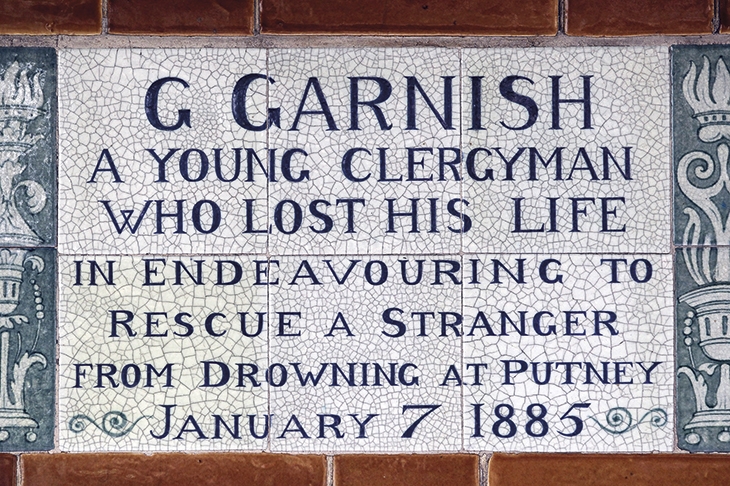Folajimi Olubunmi-Adewole died last weekend saving a woman’s life. Hearing her cries as she fell into the Thames from London Bridge, the 20-year-old, known as Jimi, handed his phone to a friend, told him to call the police, and with another passer-by dived into the river. The other man and the woman were rescued. Jimi was not.
His family have called for his heroism to be publicly remembered. A few minutes’ walk from the flowers left for Jimi on the riverbank sits an unassuming remnant of Victorian public-spiritedness, inspired by the same desire to remember everyday heroism.
The Memorial to Heroic Self-Sacrifice is in the former churchyard of Aldersgate’s St Botolph church, now called Postman’s Park after the old General Post Office building which bounds the southern edge. Designed by Ernest George, it’s a pitched timber structure rather akin to a village cricket pavilion. ‘At once moving and unintentionally quaint’, as Pevsner puts it.
The artist George Frederic Watts conceived the monument in 1887, arguing for ‘some permanent memorial to the deeds of heroic men, the sacrifice of whose lives is being constantly made and as quickly forgotten’. Inside are 54 ceramic tiles designed by William De Morgan and embedded along the wall, each emblazoned with the name of someone who sacrificed him- or herself for another. In a painterly script, the tiles display the heroes’ occupation, the date of their death and a short description of the events preceding it.
There is little apparent logic in the names Watts chose to remember. Many had died years, if not decades, before the memorial — then far from complete — was unveiled in 1900. The earliest, from 1863, is dedicated to a ‘pantomime artiste’ whose dress was enveloped in flames as she tried to extinguish another performer’s costume.
Included too is a G. Garnish, ‘a young clergyman who lost his life in endeavouring to rescue a stranger from drowning at Putney’. No record can be found of the Revd Garnish in any London parish records, nor are there any reports of an inquest or funeral for the young priest. Two days after the first reports of the incident, the Mid-Surrey Gazette suggested that other contemporary newspapers had been ‘the victims of a hoax’.
Watts found his ‘humble heroes’ by asking members of the public to send him newspaper clippings. The lack of any formal vetting process shows just how personal the project was. It was Watts who stumped up the considerable £402 cost for the construction. In the centre of the incomplete wall of plaques is a small wooden shrine to him.
Could Jimi be added to the Watts Memorial? In 2009 Leigh Pitt’s name was added nearly 80 years after the previous tile. Pitt, a photocopier engineer who drowned saving a boy in a London canal, is given the faux-Victorian title of ‘reprographics operator’. Historian John Price, of the Friends of the Watts Memorial, is unconvinced by attempts to see modern names included. He wants the listed monument to be completed with the names Watts intended to include before his death in 1904, and for the gardens to be turned into a larger memorial with modern plaques placed around the park. ‘I want people in 100 years’ time to go to Postman’s Park and say, “Look at what Jimi did”.’







Comments